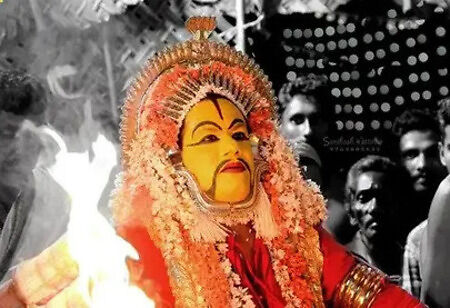
Loved Buta Kola in 'Kantara'? Here Are Some Mind-Boggling Art Forms in Karnataka


Karnataka is rich in heritage and diversity. It is the house of ritualistic dances. It is a treasure house of various dance forms. A diverse and dynamic range of artistic disciplines is practiced in Karnataka. While most of them, based on regional tradition and customs, include percussion, dance, and drama, others even feature mysticism. Here are the different art forms of Karnataka:
Beesu Kamsale
The dancing style known as Beesu Kamsale, which combines a great deal of aesthetic sublimity and martial agility, is intimately related to the practices of Male Mahadeshwara devotion. The Kamsale, a disc that resembles a cymbal, is played in time with hymns that extol the glory of Lord Mahadeswara.
Suggi Kunita is a harvest celebration dance that is mostly performed by farmers. Performers perform dances and occasionally sing to the beat of drums while holding sticks and peacock feathers. They wear lovely costumes decked with wooden headgear, carved birds, and flowers.
Ummathat
Ummathat is a stunning Coorg cultural dance made popular by the lovely Kodava women. They dance in circles to the beat of hand-held brass cymbals while wearing the customary red brocade saree, jewelry, and crimson vermilion on their foreheads. The dance, done to please the goddess Cauvery and is accompanied by singing, is typically performed during festivals, weddings, and other special events.
The dance known as Puja Kunitha is offered to the goddess Shakti. During the performance, the dancer wears a Puje, a five-foot-tall bamboo frame decorated with lovely sarees and flowers, on their head. Without a specific plot, the dancer can follow the action while performing acrobatic movements.
Parijatha
This age-old folk theater is centered on Lord Krishna's conflict with Indra over the Parijata tree. They are often outdoor concerts that are well-known for their many witticisms. Krishna Parijatha is enjoyable for the audience because of its straightforward stories and conversation, as well as the performers' spontaneity and spontaneous improvisations.
Dollu Kunitha
The Dollu Kunitha is a potent dancing style that features synchronized group forms, and aerobatic maneuvers performed to the rhythm of drums. The dance is performed by the shepherd community known as Kurubas to honor their deity, Beereshwara. Dollu Kunitha, which features around a dozen artists swaying in time to the beat of the Dollu or the drum, is a main attraction at religious festivals in the villages of Karnataka.
The Jaggahalige, a sizable percussion instrument fashioned from bullock wagon wheels and covered in buffalo hides, is employed in this traditional art. The dancers march to the throbbing rhythm of enormous drums, usually consisting of roughly 15 people. Festivals like Ugadi and Holi feature Jagghalige Kunitha performances.
The Chowdike Mela is held by the followers of Yellamma, the patron deity of North Karnataka's rural inhabitants. A special stringed instrument called a Chowdike is played to honor the deity. Typically, the singers devote their entire life to praising the heavenly beauty.
A pair or trio of dancers wearing ornate masks executes the holy, ritualistic dance known as Somana Kunitha. The core of the performance is made up of tales of how the Somas came to be given the responsibility of protecting and honoring the local deities.
Goravara Kunita
Another type of dance performed by followers of Lord Shiva is called Goravara Kunita. The performer will be dressed in black and yellow apparel that sways to the ethereal sounds of the flute and the damaruga, as well as bekasin-made fur hats. Songs with profoundly spiritual undertones passed down through centuries accompany their trance-like dances.
Veeragase
The name Veeragase is derived from the mythical Hindu hero Veerabhadra. The dancers will be holding the wooden plaque of Veerabhadra in the left hand and the sword in the right hand while the players will be clad in vibrant garb and traditional headgear. The cultural practice entails the ritualistic piercing of the tongue with a needle.
Yakshagana
Yakshagana is one of Karnataka's most sophisticated dance-drama art forms. It is a unique blending of dance, music, song, intellectual debate, and vibrant costumes. Using song, music, dance, and drama together is unusual. Yaksha (celestial) Gana is a performance in front of an audience as a celestial world comes to life amid raucous chanting and drumming and dancers wearing eye-catching costumes (music). In open-air theatres, usually beside the paddy fields after the winter crop has been harvested, performers in beautifully decorated costumes dance to the beat of drums. Though women are now a part of Yakshagana troupes, traditionally, men play all roles, even the female ones. A typical cast consists of 15 to 20 actors and a Bhagavatha, the master of ceremonies and the main storyteller. The performances draw crowds from far and wide, with a fair-ground atmosphere pervading the venue till dawn.
Bhootha Aradhane
In the coastal towns of Karnataka, Bhootha Aradhane, or demon worship, is particularly widespread. Drums are beaten and firecrackers are set off as the 'bhootha' idols are carried out in a procession.
The idols are set up on a pedestal as the procession comes to an end. A dancer impersonating the devil he represents spins around while brandishing a sword and jingling bells. He becomes possessed and behaves like an oracle while frantically pacing up and down.
Young guys typically form regiments of five to ten or more people, with three to five men dressed as tigers and painted, as well as a band called thaase in Tulu, which has two or three drummers. The group manager is accompanying this squad. These troops will be moving through the streets of their cities during Navratri while their bands' drum beats accompany them. They perform for around ten minutes at residences, places of business, or on the side of the road before asking for donations from onlookers.